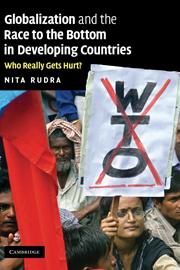Book contents
- Frontmatter
- Contents
- List of figures
- List of tables
- Preface
- 1 Introduction
- 2 The race to the bottom in developing countries
- 3 Who really gets hurt?
- 4 LDC welfare states: convergence? What are the implications?
- 5 Globalization and the protective welfare state: case study of India
- 6 Globalization and the productive welfare state: case study of South Korea
- 7 Globalization and the dual welfare state: case study of Brazil
- 8 Conclusions
- Appendix A LDC social spending
- Appendix B Assessing potential labor power
- Appendix C Additional tests for the RTB hypothesis
- Appendix D Variables in the inequality model
- Appendix E Technical notes on Gini coefficients
- Appendix F LDC Gini coefficient statistics
- Appendix G Robustness check
- Appendix H Conditional impact of trade on inequality
- Appendix I Descriptions and sources of variables
- Appendix J Cluster results minus outcome variables
- Appendix K Dendrogram for cluster analysis
- Appendix L Poverty tables
- Appendix M Social expenditures on social security, health, and education in India (percent of GDP) based on national data
- References
- Index
8 - Conclusions
Published online by Cambridge University Press: 22 September 2009
- Frontmatter
- Contents
- List of figures
- List of tables
- Preface
- 1 Introduction
- 2 The race to the bottom in developing countries
- 3 Who really gets hurt?
- 4 LDC welfare states: convergence? What are the implications?
- 5 Globalization and the protective welfare state: case study of India
- 6 Globalization and the productive welfare state: case study of South Korea
- 7 Globalization and the dual welfare state: case study of Brazil
- 8 Conclusions
- Appendix A LDC social spending
- Appendix B Assessing potential labor power
- Appendix C Additional tests for the RTB hypothesis
- Appendix D Variables in the inequality model
- Appendix E Technical notes on Gini coefficients
- Appendix F LDC Gini coefficient statistics
- Appendix G Robustness check
- Appendix H Conditional impact of trade on inequality
- Appendix I Descriptions and sources of variables
- Appendix J Cluster results minus outcome variables
- Appendix K Dendrogram for cluster analysis
- Appendix L Poverty tables
- Appendix M Social expenditures on social security, health, and education in India (percent of GDP) based on national data
- References
- Index
Summary
The governments of the South…are in any case deprived of the resources required for the financing of social policies or for redistribution. They are in effect victims of…the unbridled race to reduce taxation and social expenditures. [B]y constraining the governments of the South to respond to the market and the international financial institutions rather than to the aspirations of the peoples, the present globalization…has built a world where persons and people are put to the service of economic growth, productivity and financial profitability.
(Global Call to Action against Poverty [GCAP], March 2005, emphasis added)Globalization wrecks…communities, impoverishes our people and fosters exclusion and individualism.
(Donald Kasongi of Tanzania World Social Forum, 2004, Agency for Co-operation and Research in Development [ACORD])Along with optimism for progress, the ascendance of global capitalism has given rise to fears of decreased welfare protections and benefits, as well as a loss of sovereign power for individual nations. Academics, journalists, policy-makers, and activists around the world caution that globalization will inevitably lead to a race to the bottom. According to the RTB hypothesis, in a world unhindered by restrictions on trade and capital flows, investors will pursue the highest rate of return, wherever that may be found. Nations that go counter to the market by protecting their citizens from the worst of its effects could lose out in the competition for global business and funds. Safety nets, environmental standards, and acceptable labor costs and protections could all raise production costs or risk lower profit margins.
- Type
- Chapter
- Information
- Globalization and the Race to the Bottom in Developing CountriesWho Really Gets Hurt?, pp. 212 - 223Publisher: Cambridge University PressPrint publication year: 2008

